FW Awards: Meet the Dairy Farmer of the Year finalists
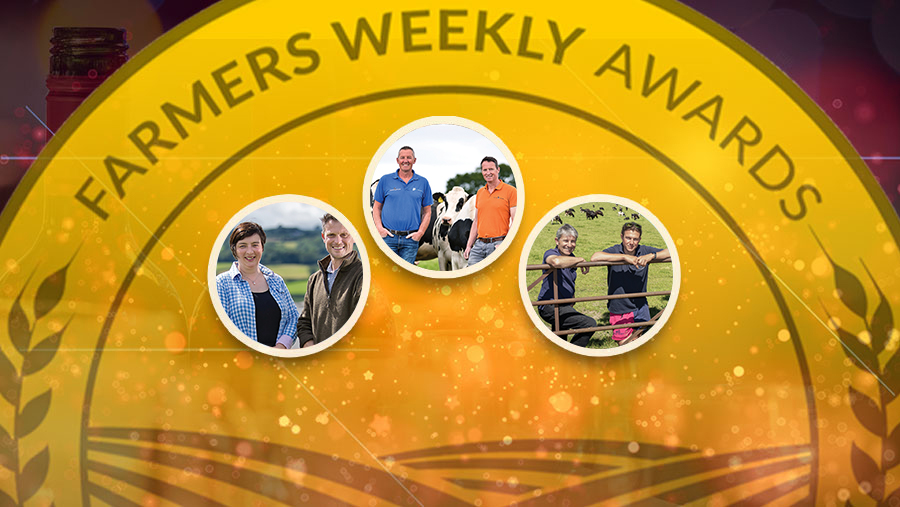
Three strong businesses demonstrate how planning, measuring and reviewing achieve excellent results on their dairy units – both financially and technically.
Finalists
- Rachel and Rheinallt Harries, Llwynmendy Uchaf, Carmarthenshire
- Chris and Mike King, Two Pools Farm, Gloucestershire
- John and Simon Martin, Nunton Farm, Wiltshire
The judges
- William Baillie – Dairy Farmer of the Year 2023, running a 400-cow, high-yielding housed herd near Biggar in Lanarkshire
- Gaynor Wellwood – Independent dairy business consultant and a partner in a 300-cow spring block-calving herd in Leicestershire
- Shirley Macmillan – Farmers Weekly deputy livestock editor with more than 30 years’ experience in the dairy industry
See also: Farmers Weekly Awards 2023: Dairy Farmer of the Year
Rachel and Rheinallt Harries, Llwynmendy Uchaf, Carmarthenshire
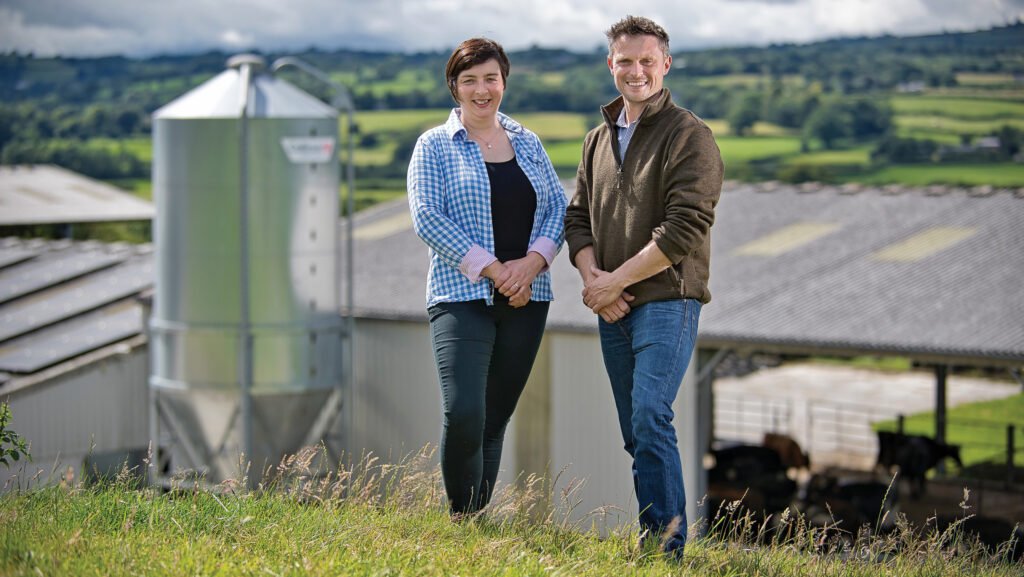
Rachel and Rheinallt Harries © Richard Stanton
As a first-generation dairy farmer, Rheinallt Harries got his foothold in dairying by teaming up with a like-minded friend to secure a tenancy in 2011.
They ran a 110-cow split-block herd, growing to 200 cows by 2016.
When he married Rachel, Rheinallt sold his share to fund their own 40ha tenancy. This early collaboration, together with good financial discipline, underpins the business.
The couple calved 120 in-calf heifers in spring 2017 and have since grown their acreage through good relationships with neighbours.
This allowed them to make silage and rear youngstock off the farm, expand the dairy herd and buy an 11ha smallholding for wintering dry stock, with the farmhouse let as a holiday cottage.
The biggest challenge has been borrowing money as a tenant, says Rheinallt. His policy was to deliver ahead of budgets and spend wisely, while ensuring all capital work was done out of cashflow.
The business
Lacking the scale to employ full-time staff, the couple set up a simple system and the infrastructure to make work easy. This included a new water system, paddocks and 4.6km of tracks.
There are automatic scrapers, and youngstock housing has observation cameras and scrapers.
Recent additions include auto-drafting operated via ear tags, and grant funding helped finance covering the winter feed and collecting yard to divert rainwater.
Benchmarking in two discussion groups focuses on reducing production costs.
The farm’s 50kW solar system on the shed roof has cut imported electricity by 32%. Solar energy now heats parlour water for the afternoon wash and the lagoon slurry bubbler during the day.
Roof rainwater is harvested and used in the foot-bath and for crop spraying.
Rainwater captured from the floating slurry lagoon cover is UV filtered and used to wash the parlour, reducing pressure on the farm’s borehole.
Technical performance
From their first season producing 4,900 litres a heifer, the couple increased performance to 6,400 litres (555kg milk solids) from 1.4t of concentrates.
However, yield dropped by 1,000 litres in 2023 because of bad weather and high concentrate prices.
Soil sampling supports milk production from grazed grass. Rheinallt digs test holes to check compaction, waterlogging and earthworm counts.
He uses the What3words app to identify the same spot each year to monitor changes.
More than 100ha has been reseeded to improve grass quality, including clover in the mixes for both grazing and silage leys.
Soya was dropped from the diet in 2020, and grass sampling helps determine the protein content needed in the cake (12-16%).
They have measured their carbon footprint for six years and the latest figure is 0.94kg carbon dioxide equivalent per standard litre – 22% lower than their milk buyer’s baseline.
They halved nitrogen use on the platform to 124kg and plan to replace more artificial fertiliser through better use of slurry, particularly on silage ground.
The future
Having built up a profitable herd, their targets are to calve 240 cows in spring 2025 and recoup their 4,000 litres milk from forage – then have a “rest”.
But they are already thinking ahead about ways to grow their business while helping others get on the farming ladder.
Their relief milker Thomas Ellis is keen to progress within the industry, and the Harries have involved him in their own management decisions and benchmarking.
The aim is to look for a second dairy unit, which Thomas can manage with a view to buying a share of the livestock as a pathway to owning his own dairy business.
In numbers
- 10-week calving block target
- 9.5% lameness rate
- 11.5% mastitis rate
- 3,375cu m rain captured from the lagoon floating cover
- 124kg/ha nitrogen use
Farm facts
- Tenants on 197ha, of which 60ha grazing platform
- Own 11ha with housing for 95 heifers plus a holiday cottage
- 200 crossbred cows
- Spring block calving
- 5,400 litres at 4.76% fat and 3.74% protein
- 1,130kg concentrates
- Target 4,000 litres from forage
- 9,000cu m covered slurry lagoon (12 months’ storage)
- Selling milk to Leprino Foods
The judges liked
- Good grassland management and stockmanship
- Simple calf rearing system with excellent results
- Good business performance and cost of production
- Achieved land ownership and option to rent out smallholding
What the judges say
“Rheinallt and Rachel are progressive and dynamic young farmers who have grown a business from nothing via excellent collaboration. They are running a profitable, low-carbon-footprint setup with good technical performance.”
Chris and Mike King, Two Pools Farm, Gloucestershire
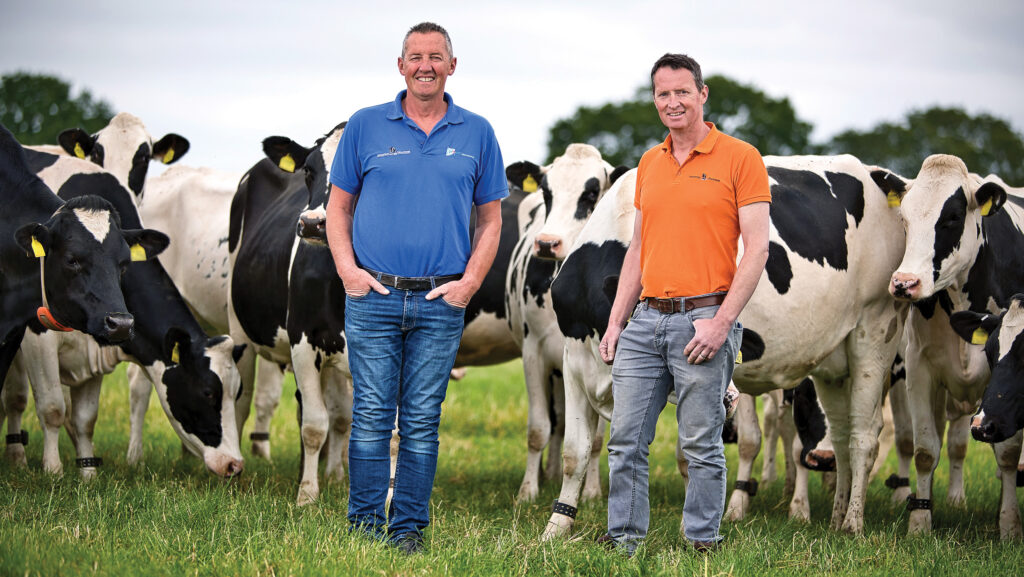
Mike (left) and Chris King © Richard Stanton
Brothers Mike and Chris King operate a data-driven, professional business that is focused on producing a high-quality food product while growing and planning for succession.
They believe yield drives profit, and profit grows their business. “It allows us to be sustainable and it is the first figure we look at,” says Mike. “We analyse what we do and see how we can do it better.”
When their milk buyer went bust, a serious marketing campaign led them to gain first a Muller contract, then an M&S one.
At the same time, a full business viability and sustainability review resulted in land purchase and the merging of two 300-cow herds to drive efficiency.
The result is a purpose-built youngstock rearing unit plus a site that can milk and house 1,000 cows, employing 14 full-time and 14 part-time staff.
The business
Passionate about training people and nurturing excellent stockmanship, the brothers buy in training and technical advice from national specialists.
Protocols and a formal organisational structure are backed up by strong communication: two-way radios, WhatsApp groups and weekly and monthly team meetings.
“Staff retention is our number-one thing after the cows – and it’s our strength, as we have employees who have been with us over 10 years,” says Mike.
“We like to show interest in our staff, train and progress people. We don’t have a set training budget but have got a schedule we follow, from management and nutrition to mobility scoring.”
Technical performance
High yields go with high welfare standards in this business.
Fresh calvers are milked four times a day in their first 90 days of lactation for better feed efficiency and less stress. No cow group is in the collecting yard for more than an hour.
First-lactation heifers are run as a separate management group until drying off. Free of bullying and stress, these heifers yield 86% of the mature cow milk yield.
As part of the Kings’ milk contract, cows graze from 100 days in milk, moving round 20 paddocks on a 40ha (99-acre) platform getting 2kg/day of grass dry matter.
They have free access to the total mixed ration to maintain their intakes of a methane inhibitor.
The farm’s estimated carbon footprint is 600-700g carbon/litre on GWP* 100.
Chris says they are also looking at reducing carbon further through breeding for feed efficiency traits, health traits, fertility and locomotion.
Just-in-time calving is in three rubber-floored calving pens, watched by cameras.
With two people always on shift, a slick system ensures pens are cleaned and disinfected after every calving and newborns are weighed, tagged and fed colostrum in the calf kitchen next door.
Calves are then transferred to the heifer unit 45 minutes after birth.
The future
Limited by land and conscious of succession, the brothers – fourth-generation farmers with four children between them – have looked to grow their business by using their management skills.
They have taken over management of a 400-cow dairy 25 miles away. The plan is to move to a full tenancy next year and manage it along the same lines as their current farm.
They have also set up two joint ventures to finish beef-cross calves and start an on-farm milk vending site, calculating that set-up costs will be paid back in three years.
In numbers
- 92% heifers calving for a second time
- 8 months of muck storage
- 13,688kg herd average milk yield
- 4,551 litres milk from forage
- 29% pregnancy rate
- 23.8 months at first calving
Farm facts
- 810 milking Holstein cows
- 534 replacement youngstock
- 330 beef stores
- Three-times-a-day milking
- 724ha including 356ha of maize for forage and grain, 169ha of wheat and 209ha of grass for multicut silage
- 260kg/ha of fertiliser product
- Selling to M&S on a Muller contract
- 850mm annual rainfall
The judges liked
- Impressive, tidy unit
- Attention to detail and written protocols
- Staff management and organisational structure
- Profit is primary goal
- Separate first-lactation management group
- Use big data sets to make decisions
What the judges say
“Mike and Chris maintain high standards of welfare, know their figures and get the best professional input they can hire. Decisions are data driven, and they have planned well for succession.”
John and Simon Martin, Nunton Farm, Wiltshire
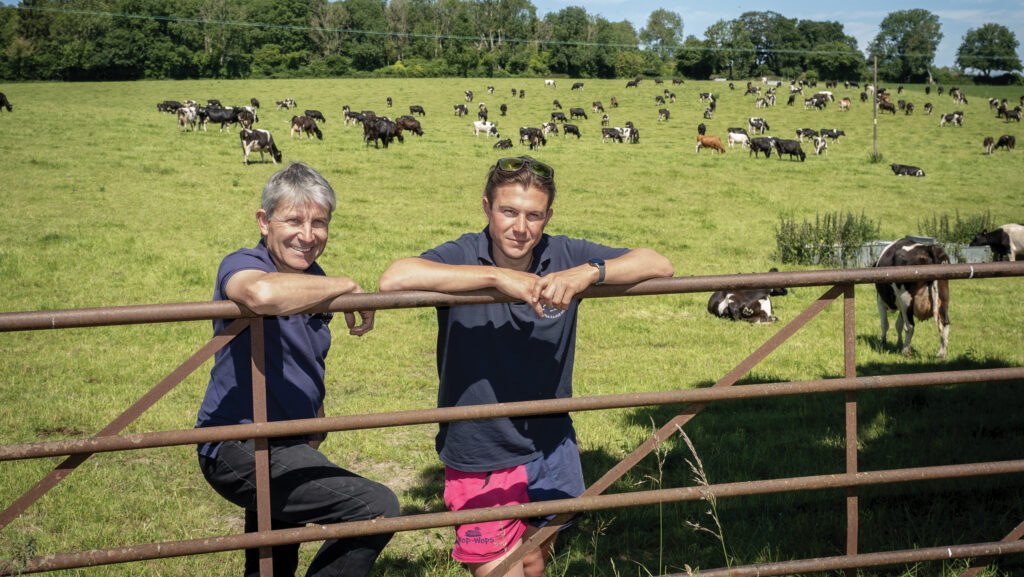
Simon (left) and John Martin © Kathy Horniblow
Father-and-son team Simon and John Martin work in harmony and have used their complementary skills to develop their 240-cow herd to an 800-cow split-block business and diversify into retailing.
Their aim is to have a profitable and sustainable system that copes with price volatility, while also having an enjoyable business with a succession plan.
A simple system, run to a high standard, combines Simon’s experience with John’s push for new technology and ideas. “We don’t agree on everything, but work through it,” says Simon.
About 3% of their milk is pasteurised on farm and sold through vending machines and cafés.
They are keen participants in their local community, including hosting Open Farm Sunday and the village nativity play.
The business
The Martins farm in partnership with their landlord, Lord Radnor. They own 50% of the assets and work on a 50:50 profit share agreement. This has allowed them to invest and borrow to grow their business.
With a team all aged under 27, John has introduced team meetings and personality profiling to help identify communication styles and strengths. He adapted work rotas to ensure staff milk only one weekend in three.
There is also a focus on training and development. “We’ve got to enjoy it. It’s a passion and a great lifestyle for us and it has got to be the same for staff,” he says.
Delegating administrative tasks to a secretary one day a week has given John more time to manage the dairy and Simon the chance to take a step back.
John is also keen to give staff the tools to do the best job they can and has invested in time-savers such as an auto teat sprayer, a second-hand robot for pushing up feed in winter, and cameras to monitor calving and bulling.
Technical performance
Simon is a long-term rotational grazing fan and cows graze from February to November.
Each calving block has its own grazing platform. He measures grass weekly, inputting the data to feed budgeting software.
The target is a robust cow producing 500kg milk solids and to push milk from forage to 50%, while increasing grass yields to 12t dry matter/ha.
John started milk recording a year ago to rank cows according to their efficiency. He says autumn calvers are producing 7,000 litres from 1.7-1.8t of cake, while the spring batch averages 5,500 litres from 1.3-1.4t.
Multicut silage for the past two years is “shrinking the gap” between quality and bulk, says John.
The future
The rotary could milk 1,000 cows, but Simon and John are not keen on increasing cow numbers. Instead, they agree on doing a better job more efficiently.
This includes identifying the best cows to breed replacements from, increasing milk from forage, and targeting feed inputs.
“We have had an extensive period of expansion and now it’s consolidation and efficiency,” says Simon. He and John are looking at data, such as feed efficiency, in more detail and analysing it.
“With a grazing base and lower inputs, we have got to be efficient,” he adds.
John wants to use the autumn and spring rotation planners in the grazing software to improve grazing efficiency.
Sowing more legumes into swards should reduce fertiliser inputs, he says, while keeping summer growth.
To help improve cow fertility – eventually cutting both blocks to nine weeks – as well as reduce workload at mating, John is investigating heat detection collars.
The numbers
- 6 full-time staff
- 5 milk vending machines
- 9.44t/ha average grass dry matter yield
- 47% of milk from forage
- 700-750mm annual rainfall
Farm facts
- Farming in partnership with landlord and profit-sharing
- 500ha including 54ha lucerne and 16ha traditional, flooded water meadows
- 800 crossbred cows
- Split block-calving: 450 cows in spring, 350 in autumn
- 90 heifers in spring block; 130 in autumn block
- Supplying BV Dairies
- Rainwater harvesting
- 30kW roof-mounted solar panels
- 70-point rotary
The judges liked
- Making the most of a unique partnership with landlord
- Drive and ambition
- Have targets and a clear set of objectives
- Excellent work in the community
- Next generation onboarded successfully
- Above-average level of monitoring and analysing figures
- Good diversification
What the judges say
“Simon and John are impressive all-rounders – they manage a good work/life balance for the business owners and their staff, are on top of their business and know their figures.”
A word from our sponsor
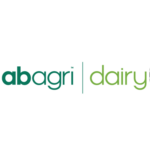
“We believe in Britain’s brilliant dairy industry and are delighted to support an award recognising dairy farmers who produce sustainable, nutritious food. My congratulations to all the finalists this year for setting the standard of excellence.”
José Nobre, chief executive, AB Agri Dairy
